The Helminthological Society of Washington - Peru State College
The Helminthological Society of Washington - Peru State College
The Helminthological Society of Washington - Peru State College
Create successful ePaper yourself
Turn your PDF publications into a flip-book with our unique Google optimized e-Paper software.
RESEARCH NOTES 197<br />
live feature not reported previously in any species<br />
<strong>of</strong> Accacladocoelium. This feature raises the<br />
possibility <strong>of</strong> an undescribed species within the<br />
genus.<br />
We thank Yolanda Hornelas <strong>of</strong> the Institute<br />
de Ciencias del Mar y Limnologfa, UNAM, for<br />
helping with the SEM photomicrographs. Rebeca<br />
Gasca and Eduardo Suarez-Morales, <strong>of</strong> El<br />
Colegio de la Frontera Sur-Unidad Chetumal<br />
kindly supplied the biological material.<br />
Literature Cited<br />
Alvarino, A. 1964. Bathymetric distribution <strong>of</strong> chaetognaths.<br />
Pacific Science 18:64-82.<br />
. 1965. Chaetognaths. in Harold Barnes, ed.<br />
Annual Review <strong>of</strong> Oceanography and Marine Biology.<br />
3:115-195.<br />
Dawes, B. 1958. Sagitta as a host <strong>of</strong> larval trematodcs,<br />
including a new and unique type <strong>of</strong> cercaria. Nature<br />
182:960-961.<br />
. 1959. On Cercaria owreae (Hutton, 1954)<br />
from Sagitta hexaptera (d'Orbigny) in the Caribbean<br />
plankton. Journal <strong>of</strong> Helminthology 33:209-<br />
222.<br />
Furnestin, M. L., and J. Rebecq. 1966. Sur 1'ubiquite<br />
de Cercaria owreae (R. F. Hutton, 1954). Annales<br />
de Parasitologie 41:61-70.<br />
Hutton, R. F. 1952. Schistosome cercariae as the<br />
probable cause <strong>of</strong> seabather's eruption. Bulletin <strong>of</strong><br />
Marine Science <strong>of</strong> the Gulf and Caribbean 2:346-<br />
359.<br />
. 1954. Metacercaria owreae n. sp. an unusual<br />
trematode larvae from the Florida Current. Chaetognaths.<br />
Bulletin <strong>of</strong> Marine Science <strong>of</strong> the Gulf<br />
and Caribbean 4:104-109.<br />
Odhner, T. 1911. Zum natiirlichen System dcr digenen<br />
Trematoden. Zoologischer Anzeiger 4:513—<br />
531.<br />
Margolis, L., G. W. Esch, J. C. Holmes, A. M. Kuris,<br />
and G. A. Schad. 1982. <strong>The</strong> use <strong>of</strong> ecological<br />
terms in parasitology. Journal <strong>of</strong> Parasitology 68:<br />
131-133.<br />
Suarez-Caabro, J. A. 1955. Quetognatos de los mares<br />
Cubanos. Memorias de la Sociedad Cubana de<br />
Historia Natural 22:125-180.<br />
J. Helminthol. Soc. Wash.<br />
66(2), 1999 pp. 197-201<br />
Research Note<br />
New Host and Locality Records for Three Species <strong>of</strong> Glypthelmins<br />
(Digenea: Macroderoididae) in Anurans <strong>of</strong> Mexico<br />
U. RAZO-MENDIVIL,' J. P. LACLETTE,2 AND G. PEREZ-PONCE DE LEON1-3<br />
1 Laboratorio de Helmintologla, Institute de Biologfa, Universidad Nacional Autonoma de Mexico, Ap. Postal<br />
70-153, C.P. 04510, Mexico D.F., Mexico (e-mail: ppdleon@servidor.unam.mx), and<br />
2 Departamento de Inmunologia, Institute de Investigaciones Biomedicas, Universidad Nacional Autonoma de<br />
Mexico, Ap. Postal 70228, C.P. 04510, Mexico D.F., Mexico<br />
ABSTRACT: During an inventory <strong>of</strong> the helminth parasites<br />
<strong>of</strong> amphibians from several localities in Mexico,<br />
trematode parasites <strong>of</strong> the genus Glypthelmins from 5<br />
species <strong>of</strong> frogs were studied. Three species <strong>of</strong> Glypthelmins<br />
were collected from Rana montezumae, Rana<br />
dunni, Rana neovolcanica, Rana megapoda, and Rana<br />
vaillanti. New host and locality records for Glypthelmins<br />
quieta and Glypthelmins californiensis in anurans<br />
from Mexico are established, and we report Glvpthelmins<br />
facioi for the first time from R. vaillanti from Los<br />
Tuxtlas, Veracruz <strong>State</strong>. Diagnostic characters for each<br />
parasite species and sister-group relationships are presented.<br />
KEY WORDS: Digenea, Macroderoididae, Glypthelmins<br />
spp., anurans, systematics, frogs, Rana spp.,<br />
Mexico.<br />
' Corresponding author.<br />
<strong>The</strong> genus Glypthelmins was established by<br />
Stafford (1905) to include Distomum quietum<br />
Stafford, 1900, parasitic in Rana catesbeiana<br />
Shaw, 1802, Rana virescens Kalm, 1878, and<br />
Hyla pickeringll Holb, 1890, all from Canada.<br />
At the present time there is controversy about<br />
the species comprising the genus Glypthelmins,<br />
primarily because the original description <strong>of</strong> the<br />
type species <strong>of</strong> Glypthelmins was incomplete.<br />
This, and some degree <strong>of</strong> intraspecific morphological<br />
variability among some members <strong>of</strong> the<br />
genus, have led to taxonomic uncertainty concerning<br />
the species. This confusion has resulted<br />
in investigators creating nonphylogenetic<br />
groups, and some species that should be included<br />
in Glypthelmins were assigned to other gen-<br />
Copyright © 2011, <strong>The</strong> <strong>Helminthological</strong> <strong>Society</strong> <strong>of</strong> <strong>Washington</strong>
















